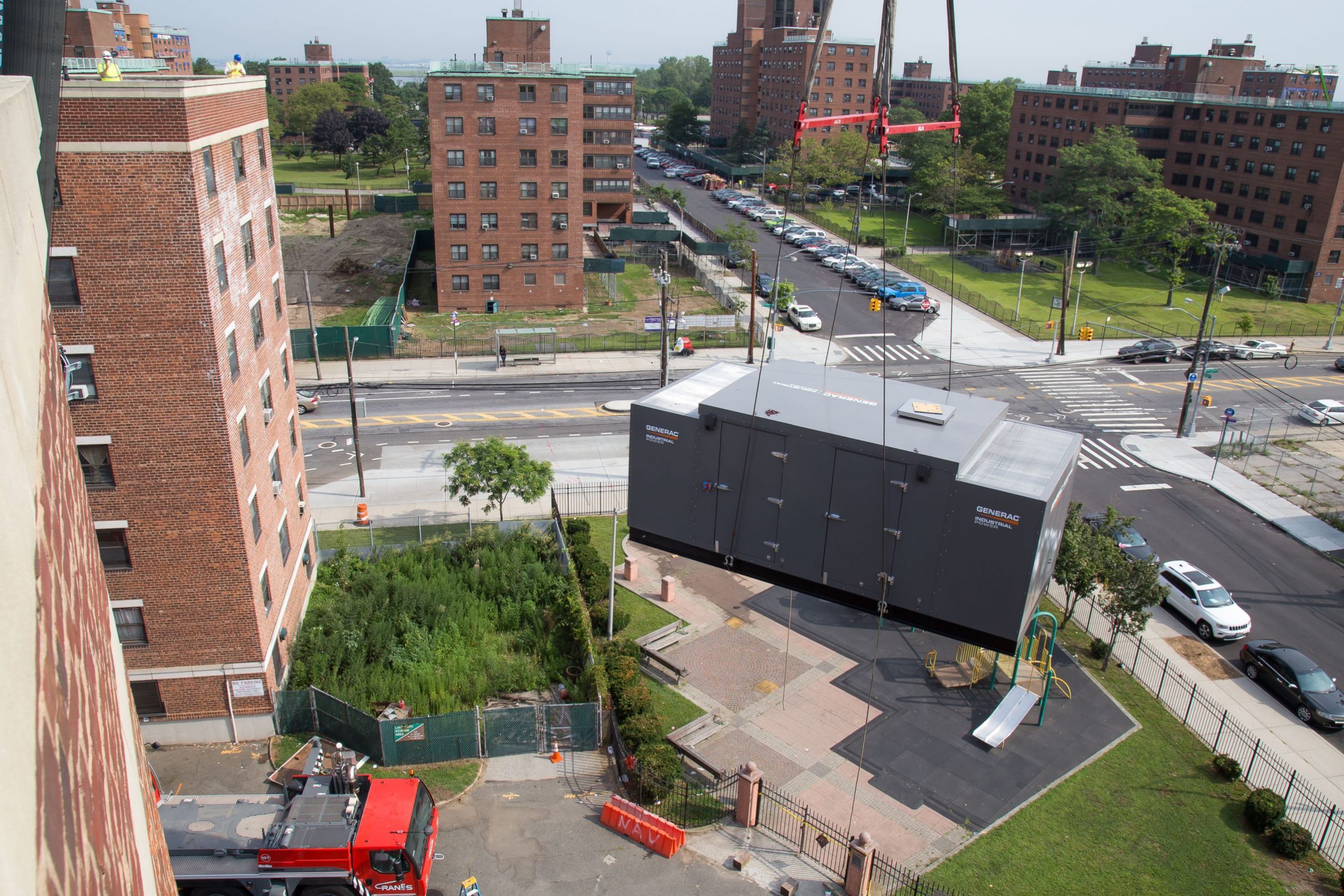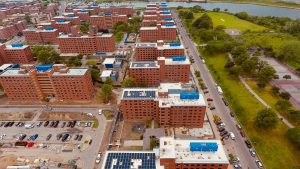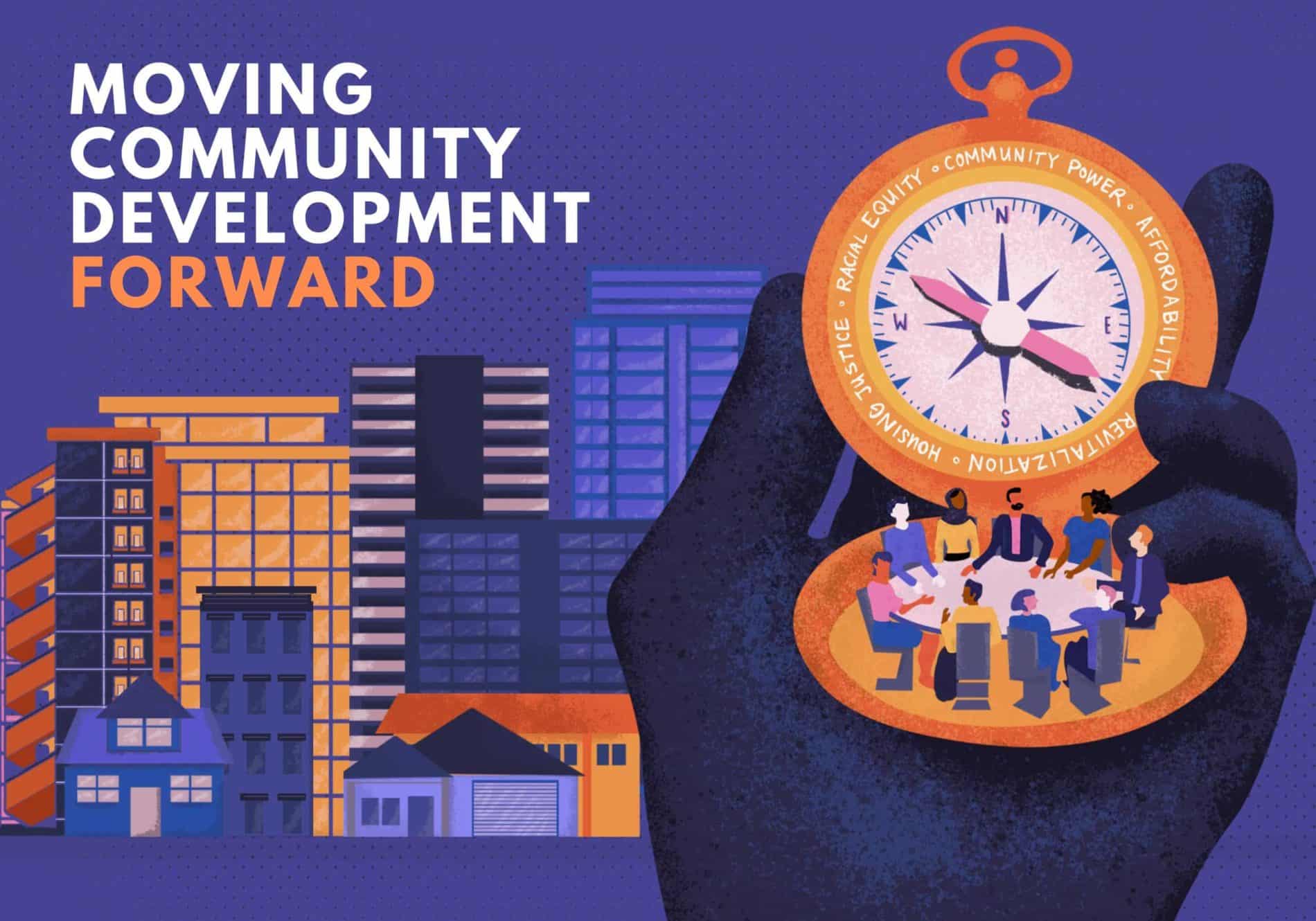
Ocean Bay (Oceanside) gets a new resiliency generator lifted on to the roof. Photo courtesy of NYCHA
When the remnants of Hurricane Ida struck the Northeast in early September, the region was inundated by devastating flash floods. Across four states, the storm killed more than 40 people, caused up to $24 billion in property damage, and knocked out power to 150,000 homes. New Jersey and New York City were hit particularly hard—30 New Jersey residents drowned in their homes and vehicles, and in NYC, 13 residents died, most drowning in their basement apartments.
The storm exceeded expectations for a 500- to 1,000-year rainfall event, according to researchers at Cornell’s Northeast Region Climate Center. The event’s improbability helps to explain why the region’s infrastructure was so ill-prepared for the rapid influx of water. But extreme storms like Ida will not be so rare in the future, and our cities, along with their affordable housing stock, will need to adapt.
‘These units are in the direct path of climate change and they’re facing extinction.’
A New York City panel on climate change forecasts that, by 2050, what is now classified as a “100-year flood” will occur three times more often in New York City. Sea levels will rise by 30 inches, and there will be up to five days each year with more than 2 inches of precipitation. The panel also expects the number of days that top 90 degrees Fahrenheit in the city to triple by 2050, posing public health risks from extreme heat.
The climate crisis presents an existential threat the world over, and it’s bumping up against the affordable housing crisis in expensive metropolitan areas like New York City. The city’s population is projected to grow from 8.8 million residents to 9.2 million by 2050. That growth is expected to concentrate in the Bronx and Brooklyn, two boroughs that saw massive flooding during Ida.
As demand for housing rises, preventing climate-related disasters from eroding the already-scarce supply of affordable housing will be critical, says Laurie Schoeman, national director of resilience and disaster recovery at Enterprise Community Partners (Enterprise), a nonprofit that works to address the housing affordability crisis through policy, programming, and capital investment.
“A lot of existing affordable housing is exposed to extreme climate risk, in flood zones, in areas that are apt to burn, or in drought zones,” says Schoeman. “These units are in the direct path of climate change and they’re facing extinction.”
So, how can we protect our existing affordable housing stock from more frequent and extreme weather events, and build new housing that can withstand the effects of a warming climate? And what lessons can Ida offer to affordable housing managers and owners whose properties are at risk?
A Shifting Picture of Risk
As storms like Ida become more frequent, building owners and managers may be forced to carry flood insurance, even if they’re not within the designated flood plain. The costs will likely be significant, as federal flood insurance rates are expected to skyrocket soon to account for climate risk, and affordable housing providers can’t simply raise their rents to accommodate higher insurance premiums.
Flood risk is determined by FEMA-drawn maps, but those maps may underestimate actual risk across the country by as much as 70 percent, according to data by the First Street Foundation. As the climate warms, the number of at-risk properties will grow.
Many affordable housing developers and owners affected by Ida didn’t carry flood insurance on their buildings, Schoeman says. “If you’re not in the floodplain, why would you buy a really expensive insurance policy?” Despite being outside of the riskiest zones, these buildings still saw significant flooding, and many sustained damage to mechanical and electrical systems below their base-level elevation, a common occurrence during floods that can displace entire buildings.
[RELATED ARTICLE: Deciding Not to Rebuild After Climate-Related Disasters]
As a resilience strategy, Enterprise recommends moving equipment like boilers, furnaces, electric and gas meters, and backup generators to a higher elevation. The New York City Housing Authority (NYCHA) began acting on that advice following Superstorm Sandy in 2012, and started moving its boilers and electrical equipment above grade. According to Siobhan Watson, program manager for NYCHA’s Climate Adaptation Initiatives, that work paid off during Ida. The buildings where systems had already been moved saw no storm-related service interruptions, she says, while other NYCHA properties experienced outages.
Other Enterprise-recommended retrofits for multifamily housing to mitigate flood risk include elevating living spaces, installing sump pumps where needed, maintaining backup power systems, and using water-resistant building materials.
While renovations like these can be expensive, Schoeman hopes much of the cost can someday be offset by lower insurance premiums. Her group is working to bring that vision to fruition by partnering with insurance companies to assess which retrofits could reduce the risk of damage and bring down rates.
Preparing New York City’s Public Housing for Climate Risks
New York City’s largest permanently affordable housing asset is its public housing stock. NYCHA is North America’s largest landlord, serving more than 500,000 low-income residents across its 2,500-building portfolio and through its Section 8 programs. Following decades of disinvestment, NYCHA has an infamously large need for capital investment—$40 billion—to bring its aging developments up to a state of good repair. Given its already-massive budget hole, damage from a climate-related storm could deal a devastating blow to the agency. Projections show that 506 NYCHA buildings will be within the 100-year floodplain by 2050, making nearly one-quarter of all public housing units vulnerable to flood damage.

An aerial view of hydronic boilers on the roofs of 24 buildings at the Ocean Bay Apartments in Queens. Photo courtesy of NYCHA
To prepare, NYCHA will build resiliency work into its planned capital projects over the coming years, according to Joy Sinderbrand, NYCHA’s vice president of recovery and resilience. Much of the needed work involves moving boilers above ground, decoupling heat and hot water systems, and improving onsite drainage. NYCHA’s low-income residents are also at risk for the ill effects of extreme heat due to the warming climate. During the summer of 2020, NYCHA partnered with the city to install 16,000 air conditioner units in apartments across its portfolio.
The unexpected impact of Ida only underscores the urgency of this work, Sinderbrand says.
[RELATED ARTICLE: Designing for Climate Change]
“For the NYCHA portfolio, the flooding came very quickly, and not only in areas where we expected,” she says. “It really reshapes our thinking about how many developments are vulnerable. Partly because of the level of rain, and partly because the infrastructure at these sites was built at a time when this level of rain was not even probable.”
City Infrastructure a Key Piece
While there are several steps affordable housing owners and managers can take to protect their buildings, private citizens can only do so much. During Ida, New York City’s sewer system was badly outmatched by the downpour. With nowhere to go, water backed up into buildings across the city.
Truly fixing the problem would require upgrading the city’s 7,000-mile sewer system to handle storms like Ida, which would cost an astronomical sum. “To do the whole city, to rework all our sewers for this new reality, is probably over $100 billion,” Mayor Bill de Blasio told city councilmembers at a recent hearing on Ida recovery efforts. “That’s only going to happen with a lot of federal support.”
Currently, there’s no plan to overhaul the city’s aging sewer system.
Every property owner’s drainage lines connect to the city’s system eventually, including the drainage systems at NYCHA properties. Just as NYCHA relies on the city’s sewer system to carry water away, the city depends on NYCHA’s large expanses of open space—second only to the NYC Parks Department—to absorb stormwater runoff. In that way, the bioswales and stormwater management systems installed at NYCHA developments are a major asset not only to public housing residents, but to the city as a whole.
A recently adopted ordinance will require all city-funded capital projects to incorporate forward-looking resiliency guidelines by 2027. The guidelines include building design elements like permeable surfaces, green roofs, bioswales, and shaded areas to help new structures sustain extreme heat, tidal inundation, and rainfall at the level they’re projected to occur in the region 50 years from now.
According to Schoeman, upgrading city infrastructure to handle extreme weather is just as critical to protecting affordable housing as retrofitting existing buildings, or building new ones using resilient practices.
“The industry has been approaching housing as if it’s an island,” she says. “There are a lot of things you can do to seal up a building. But if the infrastructure is not able to carry away the water, we’re going to have a problem.”
The Question of Basement Apartments
The majority of Ida’s New York City fatalities occurred in basement apartments, where 11 people died after becoming trapped by the rising flood waters.
Most basement apartments are unauthorized by the city, and so aren’t subject to the regular housing code enforcement process. If they were, many would be condemned for issues like inadequate light and ventilation, or not having multiple exits in case of an emergency.
Although there’s no reliable count of how many unauthorized basement units exist in New York City, conservative estimates put the number in the tens of thousands. Last year, the city’s Basement Apartment Conversion pilot program, which was meant to help homeowners renovate their basement units and bring them up to code through low- or no-interest loans, was defunded due to pandemic-related budget cuts. Advocates warn that by neglecting the program the city is missing an opportunity to make a key piece of its affordable housing stock safe and habitable, and putting the lives of low-income renters at risk.
“Creating a program to ensure the safety of basement units is low-hanging fruit in the affordable housing crisis,” says Annetta Seecharran, executive director at Chhaya, a Queens-based community development corporation that has advocated for the city funding basement apartment conversions. “Fining homeowners doesn’t solve the problem. Leaving these apartments doesn’t solve the problem.”
Several flood-proofing measures can make these units safer, including flood protection barrier systems, gaskets on windows and doors, backflow preventers, and alarm systems. All told, the needed retrofits cost about $100,000 per apartment on average, according to Seecharran, a sum that is cost-prohibitive for many low-income homeowners, hence the need for a city-funded program.
Many basement units will never be made safe, Seecharran acknowledges. In those cases, she says the city should use tax breaks to disincentivize homeowners from renting out their basements.
“One of the biggest challenges of this program has been housing the tenants,” while the renovations are performed, she says. “Well, now the tenants have disappeared. They found other places to stay. So this is the opportunity. Let’s rebuild quickly and bring them back in.”
After Ida, Mayor de Blasio pledged to send city workers door to door during future floods to evacuate residents living below grade. He also promised to set up a database to track all the basement units in New York City.
Building a Climate Cushion
While climate science has been clear for decades, and the impacts of the crisis are now being felt all around us, many cities and multifamily housing developers still aren’t building with future risks in mind. “Most developers build to code, and code is not necessarily looking at future conditions,” Schoeman says.
New units are still being constructed below the base flood elevation. Boiler systems are still being placed in basements. Many new buildings lack generators or backup power systems. These practices may work in the short term, but they won’t stand up to a future with more extreme weather events.
“It kills me when I see someone build a flood wall for current risk, and then the wall is overcast by water five years later because they didn’t accommodate for the rising sea level,” Schoeman says. “Don’t just consider your current risk. Consider your future risk … The message is, give yourself a cushion.”





Comments